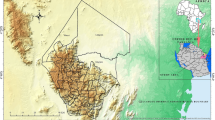Abstract
Remote sensing and Geographic Information System (GIS) are well suited to landslide studies. The aim of this study is to prepare a landslide susceptibility map of a part of Ooty region, Tamil Nadu, India, where landslides are common. The area of the coverage is approximately 10 × 14 km in a hilly region where planting tea, vegetables and cash crops are in practice. Hence, deforestation, formation of new settlements and changing land use practices are always in progress. Land use and land cover maps are prepared from Indian Remote Sensing Satellite (IRS 1C - LISS III) imagery. Digital Elevation Model (DEM) was developed using 20 m interval contours, available in the topographic map. Field studies such as local enquiry, land use verification, landslide location identification were carried out. Analysis was carried out with GIS software by assigning rank and weights for each input data. The output shows the possible landslide areas, which are grouped for preparation of landslide susceptibility maps.
Similar content being viewed by others
References
Balachandran, V., Thanavelu, C. and Pitchaimuthu, R. (1996). Marappalam landslide. The Nilgiri district, Tamilnadu, India. a case study. Proceedings, International Conference on Disasters and Mitigation, Madras, India 9–22 January, 1996.I: A4–21-23.
Bhasin, R., Eystein Grimstad, Jan Otto Larsen, Ashok K. Dhawan. Rajbal Singh, Verma, S.K. and Venkatachalam, K. (2002). Landslide hazards and mitigation measures at Gangtok, Sikkim Himalaya.Engineering Geology,64: 351–368.
Brardinoni, F., Olav Slaymaker and Marwan A. Hassan (2003). Landslide inventory in a rugged forested watershed: a comparison between air-photo and field survey data.Geomorphology,54: 179–196.
Burrough, A. Peter and Rachael, A. McDonnell (1998). Principles of Geographic Information Systems. Oxford University Press, pp. 122–127:
Dai, F.C. and Lee, C.F. (2002). Landslide characteristics and slope instability modeling using GIS, Lantau Island, Hong Kong.Geomorphology,42: 213–228.
Glade, Thomas (2003). Landslide occurrences as a response to land use change: a review of evidence from New Zealand.Catena,51: 297–314.
Gokceoglu, C. and Aksoy, H. (1996). Landslide susceptibility mapping of the slopes in the residual soils of the Mengen region (Turkey) by deterministic stability analyses and image processing techniques.Engineering Geology,44: 147–161.
Gray, D.H. and Leiser, A.T. (1982). Biotechnical slope protection and erosion control. Van Nostrand Reinhold Company, New York.
Greenways, D.R. (1987). Vegetation and slope stability. In slope stability, edited by M.F. Anderson and K.S. Richards. Wiley and Sons, New York.
Nagarajan, R., Anupam Mukherjee and Aniruddha Roy (1996). Landslide hazard assessment using remote sensing and GIS - A case study. Proceedings, International conference on disasters and mitigation. Madras, India, 19-22 January, 1996, VolumeI, PP. A4–78-84.
Panikkar, S.V. and Subramanyan, V. (1996). A geomorphic evaluation of the landslides around Dehradun and Mussoorie, Uttar Pradesh, India.Geomorphology 15: 169–181.
Parthasarathy, Y.J. and Vaidyanathn, R. (1974). Landforms over the Nilgiris. J. Geological Society of India, Vol.15.
Perotto-Baldiviezo, H.L., Thurow, T.L., Smith, C.T., Fisher, C.T. and Wu, X.B. (2004). GIS-based spatial analysis and modeling for landslide hazard assessment in steep lands, Southern Honduras.Agriculture, Ecosystems and Environment, pp. 1–11.
Seshagiri, D.N., Badrinarayanan, S., Upendran, R., Lakshmikantham, C.B. and Srinivasan, V. (1982). The Nilgiris landslide - Miscellaneous publication no. 57. Geological Survey of India.
Author information
Authors and Affiliations
Corresponding author
About this article
Cite this article
Rajakumar, P., Sanjeevi, S., Jayaseelan, S. et al. Landslide susceptibility mapping in a hilly terrain using remote sensing and GIS. J Indian Soc Remote Sens 35, 31–42 (2007). https://doi.org/10.1007/BF02991831
Received:
Revised:
Issue Date:
DOI: https://doi.org/10.1007/BF02991831




